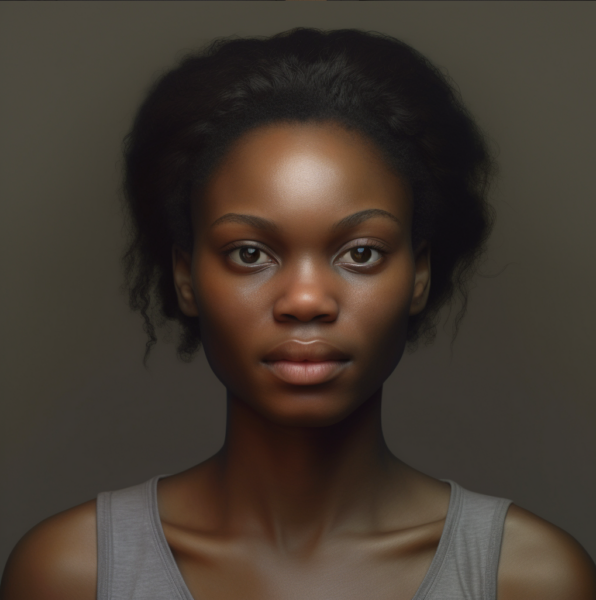Over the years several research initiatives have investigated African hair characteristics, uncovering its unique attributes and growth patterns. When juxtaposed with other ethnicities, the patterns of hair growth and hair density display more pronounced variances. This article delves into the intricacies of hair density among different ethnicities, primarily focusing on Africans / African Americans, in comparison with Caucasians, and Americans of Hispanic descent. Meticulous examinations of hair density at different scalp regions was conducted among various ethnicities in different studies, but overall the data suggest similar conclusions.
Observations Across Ethnicities
A study from 2001 looked at African volunteers from central and western Africa. In a sample of 38 Africans, half of them being men and the other half women, there was a substantial variation in hair density. On average, hair density ranged from 90 to 290 hairs per square centimeter (cm^2), with a mean density of 187 hairs/cm^2. Notably, the vertex (top crown area) region of the scalp displayed a higher hair density than the occipital (back of the scalp) and temporal (forward and above the ears) areas. Interestingly, while gender did not play a significant role in distinguishing the hair density on the vertex, disparities arose when looking at the occipital and temporal regions. Women manifested a greater hair density in the occipital area and less density in the temporal area compared to men.
A more recent 2018 study looked at 44 African Americans as well as 99 Hispanic and 23 Caucasian Americans for comparison. For Americans of Hispanic descent, hair densities at the frontal, vertex, and occipital regions were 174 ± 32, 178 ± 33, and 169 ± 31/cm^2 respectively. Individuals of African descent presented with densities of 160 ± 27, 149 ± 23, and 148 ± 25/cm^2, and the Caucasians of European descent group displayed densities of 230 ± 33, 226 ± 20, and 214 ± 28/cm^2 at the respective regions.
The differences in hair density between these groups across all scalp areas were statistically significant. When assessing each ethnicity independently, significant disparities emerged between the scalp locations as well. Among Americans of Hispanic descent, the highest density was observed at the vertex. However, for individuals of African descent and Caucasians, the frontal scalp presented the densest hair concentration. In a cumulative analysis of the data encompassing all three groups, age was a significant factor affecting hair density. On average, a decline of 0.33 hairs/cm^2 was noted with each passing year.
Historical data from small studies using different analytical methods also supports these findings. In 1999, Sperling performed a study on punch biopsies from healthy scalps of African Americans and Caucasians. The results produced similar trends in data: African Americans had a density of approximately 169-177 hairs/cm^2, while Caucasians exhibited around 280 hairs/cm^2.
The largest study to date (published 2016) on hair density covers 2249 people from 24 different ethnic groupings. While there is data on many different groups from across the world, the report indicates the lower hair densities were observed in South Africans (153 ± 30 hairs/cm^2), Western Africans (165 ± 34 hairs/cm^2), North Africans (203 ± 66 hairs/cm^2), African-Americans (176 ± 54 hairs/cm^2), and Caribbean people (178 ± 73 hairs/cm^2).
Practical Implications and Significance
The research insights collectively suggest that individuals of African descent tend to exhibit lower hair densities compared to other ethnicities. From a cosmetic standpoint, this decreased density implies that populations of African descent might be more sensitive to hair loss. The lower hair density could potentially make it harder to mask hair thinning or hair loss patterns. However, hair growth patterns and hair styles also need to be considered as they have a significant impact on overall scalp hair coverage.
Understanding these variations in hair density becomes pivotal, especially when considering hair transplantation techniques for African individuals. Furthermore, these nuances in hair density across ethnicities emphasize the need for precision when diagnosing hair disorders, gauging responses to treatments, and framing hair-centric research in populations of different ethnicities.
To conclude, the ethnic variations in hair density have tangible implications in both clinical practice and cosmetic considerations. Healthcare professionals and hair researchers are urged to be cognizant of these disparities. Recognizing and accommodating these differences can lead to more precise diagnostics and treatments, ultimately benefiting a diverse patient population.
Bibliography
11711645 {11711645:6HGVZRQV},{11711645:76ZQBIQ2},{11711645:5U6CTWF8},{11711645:RBQKQXDE},{11711645:KTHPEF7Q},{11711645:PH2973GS} 1 vancouver 50 date asc 522 https://www.keratin.com/wp-content/plugins/zotpress/ %7B%22status%22%3A%22success%22%2C%22updateneeded%22%3Afalse%2C%22instance%22%3Afalse%2C%22meta%22%3A%7B%22request_last%22%3A0%2C%22request_next%22%3A0%2C%22used_cache%22%3Atrue%7D%2C%22data%22%3A%5B%7B%22key%22%3A%226HGVZRQV%22%2C%22library%22%3A%7B%22id%22%3A11711645%7D%2C%22meta%22%3A%7B%22creatorSummary%22%3A%22Bernstein%20and%20Rassman%22%2C%22parsedDate%22%3A%221997-09%22%2C%22numChildren%22%3A0%7D%2C%22bib%22%3A%22%3Cdiv%20class%3D%5C%22csl-bib-body%5C%22%20style%3D%5C%22line-height%3A%201.35%3B%20%5C%22%3E%5Cn%20%20%3Cdiv%20class%3D%5C%22csl-entry%5C%22%20style%3D%5C%22clear%3A%20left%3B%20%5C%22%3E%5Cn%20%20%20%20%3Cdiv%20class%3D%5C%22csl-left-margin%5C%22%20style%3D%5C%22float%3A%20left%3B%20padding-right%3A%200.5em%3B%20text-align%3A%20right%3B%20width%3A%201em%3B%5C%22%3E1.%3C%5C%2Fdiv%3E%3Cdiv%20class%3D%5C%22csl-right-inline%5C%22%20style%3D%5C%22margin%3A%200%20.4em%200%201.5em%3B%5C%22%3EBernstein%20RM%2C%20Rassman%20WR.%20The%20aesthetics%20of%20follicular%20transplantation.%20Dermatol%20Surg.%201997%20Sep%3B23%289%29%3A785%26%23x2013%3B99.%3C%5C%2Fdiv%3E%5Cn%20%20%20%3C%5C%2Fdiv%3E%5Cn%3C%5C%2Fdiv%3E%22%2C%22data%22%3A%7B%22itemType%22%3A%22journalArticle%22%2C%22title%22%3A%22The%20aesthetics%20of%20follicular%20transplantation%22%2C%22creators%22%3A%5B%7B%22creatorType%22%3A%22author%22%2C%22firstName%22%3A%22R.%20M.%22%2C%22lastName%22%3A%22Bernstein%22%7D%2C%7B%22creatorType%22%3A%22author%22%2C%22firstName%22%3A%22W.%20R.%22%2C%22lastName%22%3A%22Rassman%22%7D%5D%2C%22abstractNote%22%3A%22BACKGROUND%3A%20Follicular%20transplantation%20is%20a%20method%20of%20hair%20restoration%20surgery%20that%20uses%20hair%20in%20its%20naturally%20occurring%20groups%2C%20called%20follicular%20units.%20Using%20the%20follicular%20unit%20exclusively%20in%20the%20transplant%2C%20the%20surgeon%20can%20create%20hair%20patterns%20that%20closely%20mimic%20nature.%5CnOBJECTIVE%3A%20To%20focus%20on%20various%20aesthetic%20aspects%20of%20the%20follicular%20transplantation%20procedure%20including%20hair%20distribution%2C%20hairline%20design%2C%20and%20crown%20restoration.%20Racial%20variations%20that%20affect%20the%20transplant%20will%20also%20be%20examined.%5CnMETHODS%3A%20Follicular%20transplantation%20is%20performed%20according%20to%20techniques%20detailed%20in%20a%20previous%20publication%20%28Bernstein%20et%20al.%20Int%20J%20Aesthet%20Rest%20Surg%201995%3B%203%3A%20119-32%29.%5CnRESULTS%3A%20Excellent%20cosmetic%20results%20can%20be%20achieved%20when%20aesthetic%20decisions%20are%20made%20that%20allow%20the%20surgeon%20to%20recreate%20hair%20patterns%20already%20provided%20by%20nature.%20A%20case%20study%20will%20be%20presented.%5CnCONCLUSIONS%3A%20The%20small%20size%20of%20follicular%20implants%20enables%20the%20surgeon%20great%20versatility%20in%20their%20placement.%20Follicular%20transplantation%20will%20ensure%20a%20natural%20looking%20transplant%20if%20used%20with%20good%20aesthetic%20judgment%20and%20careful%20planning.%22%2C%22date%22%3A%221997-09%22%2C%22language%22%3A%22eng%22%2C%22DOI%22%3A%2210.1111%5C%2Fj.1524-4725.1997.tb00419.x%22%2C%22ISSN%22%3A%221076-0512%22%2C%22url%22%3A%22%22%2C%22collections%22%3A%5B%22S227ET88%22%5D%2C%22dateModified%22%3A%222023-09-04T15%3A26%3A27Z%22%7D%7D%2C%7B%22key%22%3A%2276ZQBIQ2%22%2C%22library%22%3A%7B%22id%22%3A11711645%7D%2C%22meta%22%3A%7B%22creatorSummary%22%3A%22Sperling%22%2C%22parsedDate%22%3A%221999-06%22%2C%22numChildren%22%3A0%7D%2C%22bib%22%3A%22%3Cdiv%20class%3D%5C%22csl-bib-body%5C%22%20style%3D%5C%22line-height%3A%201.35%3B%20%5C%22%3E%5Cn%20%20%3Cdiv%20class%3D%5C%22csl-entry%5C%22%20style%3D%5C%22clear%3A%20left%3B%20%5C%22%3E%5Cn%20%20%20%20%3Cdiv%20class%3D%5C%22csl-left-margin%5C%22%20style%3D%5C%22float%3A%20left%3B%20padding-right%3A%200.5em%3B%20text-align%3A%20right%3B%20width%3A%201em%3B%5C%22%3E1.%3C%5C%2Fdiv%3E%3Cdiv%20class%3D%5C%22csl-right-inline%5C%22%20style%3D%5C%22margin%3A%200%20.4em%200%201.5em%3B%5C%22%3ESperling%20LC.%20Hair%20density%20in%20African%20Americans.%20Arch%20Dermatol.%201999%20Jun%3B135%286%29%3A656%26%23x2013%3B8.%3C%5C%2Fdiv%3E%5Cn%20%20%20%3C%5C%2Fdiv%3E%5Cn%3C%5C%2Fdiv%3E%22%2C%22data%22%3A%7B%22itemType%22%3A%22journalArticle%22%2C%22title%22%3A%22Hair%20density%20in%20African%20Americans%22%2C%22creators%22%3A%5B%7B%22creatorType%22%3A%22author%22%2C%22firstName%22%3A%22L.%20C.%22%2C%22lastName%22%3A%22Sperling%22%7D%5D%2C%22abstractNote%22%3A%22BACKGROUND%3A%20The%20meager%20data%20on%20normal%20hair%20density%20in%20humans%20have%20been%20gathered%20from%20a%20predominantly%20white%20population.%20Examination%20of%20scalp%20biopsy%20specimens%20from%20African%20Americans%20suggests%20that%20hair%20density%20in%20this%20group%20may%20be%20lower%20than%20in%20whites.%20This%20study%20was%20performed%20to%20quantify%20any%20differences%20between%20white%20and%20African%20American%20patients.%5CnDESIGN%3A%20A%20retrospective%20case%20series%20of%20subjects%20who%20had%20undergone%20a%20biopsy%20of%20clinically%20healthy%20scalp%20skin.%20The%204-mm%20punch%20biopsy%20specimens%20were%20sectioned%2C%20and%20all%20follicles%20contained%20within%20the%20specimens%20were%20counted%20at%20various%20levels%20%28suprabulbar%2C%20isthmus%2C%20and%20infundibulum%29%20to%20arrive%20at%20the%20number%20and%20type%20of%20hairs%20present.%5CnSETTING%3A%20Outpatient%20clinic%20in%20a%20tertiary%20care%20medical%20center.%5CnPATIENTS%3A%20A%20consecutive%20sample%20of%2022%20African%20American%20and%2012%20white%20patients%20with%20clinically%20healthy%20scalp%20skin%20specimens%20that%20were%20studied%20and%20compared%20with%20previously%20reported%20data.%5CnMAIN%20OUTCOME%20MEASURES%3A%20Patients%27%20age%20and%20total%20number%20of%20follicles%2C%20terminal%20follicles%2C%20vellus%20follicles%2C%20terminal%20anagen%20hairs%2C%20and%20terminal%20telogen%20hairs.%5CnRESULTS%3A%20Total%20hair%20density%20%28number%20of%20follicles%20per%204-mm%20punch%20biopsy%20specimen%29%20and%20total%20number%20of%20terminal%20follicles%20and%20terminal%20anagen%20hairs%20were%20significantly%20lower%20in%20African%20Americans%20%28P%3C.001%29%20than%20in%20whites%20and%20in%20a%20previously%20reported%2C%20predominantly%20white%2C%20population.%5CnCONCLUSIONS%3A%20Hair%20density%20in%20African%20Americans%20is%20significantly%20lower%20than%20that%20in%20whites%2C%20which%20must%20be%20taken%20into%20consideration%20when%20evaluating%20a%20biopsy%20specimen%20from%20an%20African%20American%20patient.%20Data%20previously%20collected%20from%20white%20patients%20may%20not%20provide%20adequate%20guidance%20when%20evaluating%20scalp%20biopsy%20specimens%20from%20African%20Americans%20and%20could%20lead%20to%20an%20incorrect%20diagnosis.%22%2C%22date%22%3A%221999-06%22%2C%22language%22%3A%22eng%22%2C%22DOI%22%3A%2210.1001%5C%2Farchderm.135.6.656%22%2C%22ISSN%22%3A%220003-987X%22%2C%22url%22%3A%22%22%2C%22collections%22%3A%5B%22S227ET88%22%5D%2C%22dateModified%22%3A%222023-09-04T15%3A22%3A54Z%22%7D%7D%2C%7B%22key%22%3A%22PH2973GS%22%2C%22library%22%3A%7B%22id%22%3A11711645%7D%2C%22meta%22%3A%7B%22creatorSummary%22%3A%22Loussouarn%22%2C%22parsedDate%22%3A%222001-08%22%2C%22numChildren%22%3A0%7D%2C%22bib%22%3A%22%3Cdiv%20class%3D%5C%22csl-bib-body%5C%22%20style%3D%5C%22line-height%3A%201.35%3B%20%5C%22%3E%5Cn%20%20%3Cdiv%20class%3D%5C%22csl-entry%5C%22%20style%3D%5C%22clear%3A%20left%3B%20%5C%22%3E%5Cn%20%20%20%20%3Cdiv%20class%3D%5C%22csl-left-margin%5C%22%20style%3D%5C%22float%3A%20left%3B%20padding-right%3A%200.5em%3B%20text-align%3A%20right%3B%20width%3A%201em%3B%5C%22%3E1.%3C%5C%2Fdiv%3E%3Cdiv%20class%3D%5C%22csl-right-inline%5C%22%20style%3D%5C%22margin%3A%200%20.4em%200%201.5em%3B%5C%22%3ELoussouarn%20G.%20African%20hair%20growth%20parameters.%20Br%20J%20Dermatol.%202001%20Aug%3B145%282%29%3A294%26%23x2013%3B7.%3C%5C%2Fdiv%3E%5Cn%20%20%20%3C%5C%2Fdiv%3E%5Cn%3C%5C%2Fdiv%3E%22%2C%22data%22%3A%7B%22itemType%22%3A%22journalArticle%22%2C%22title%22%3A%22African%20hair%20growth%20parameters%22%2C%22creators%22%3A%5B%7B%22creatorType%22%3A%22author%22%2C%22firstName%22%3A%22G.%22%2C%22lastName%22%3A%22Loussouarn%22%7D%5D%2C%22abstractNote%22%3A%22BACKGROUND%3A%20Hair%20growth%20parameters%20have%20been%20studied%20mostly%20in%20caucasian%20hair%2C%20whereas%20few%20data%20on%20African%20hair%20have%20been%20reported%20in%20the%20literature.%5CnOBJECTIVES%3A%20To%20evaluate%20hair%20growth%20characteristics%20of%20African%20volunteers%20born%20in%20Africa.%5CnMETHODS%3A%20Thirty-eight%20young%20adults%20%2819%20women%2C%2019%20men%2C%20mean%20%2B%5C%2F-%20SD%20age%2027%20%2B%5C%2F-%2010%20years%29%2C%20native%20of%20central%20and%20western%20Africa%2C%20took%20part%20in%20the%20study.%20Phototrichograms%20were%20performed%20in%20order%20to%20record%20three%20parameters%20of%20hair%20growth%3A%20hair%20density%2C%20telogen%20percentage%20and%20rate%20of%20growth.%20For%20each%20volunteer%2C%20three%20regions%20of%20the%20scalp%2C%20namely%20vertex%2C%20temporal%20and%20occipital%20areas%2C%20were%20assessed.%5CnRESULTS%3A%20Hair%20density%20varied%20from%2090%20to%20290%20hairs%20cm%28-2%29%2C%20with%20higher%20counts%20on%20the%20vertex.%20No%20significant%20difference%20between%20men%20and%20women%20was%20recorded.%20Telogen%20percentage%20showed%20wide%20variations%2C%20from%202%20to%2046%25%2C%20with%20higher%20levels%20on%20the%20temporal%20area%20and%20in%20men.%20The%20rate%20of%20growth%20fluctuated%20from%20150%20to%20363%20microm%20day%28-1%29%20with%20no%20difference%20related%20either%20to%20gender%20or%20to%20scalp%20region.%20These%20data%20were%20compared%20with%20those%20previously%20obtained%20in%20caucasian%20volunteers%20of%20comparable%20age%2C%20and%20showed%20significant%20differences%20between%20the%20two%20ethnic%20groups%20in%20all%20three%20parameters%20studied.%20Hair%20density%20in%20African%20volunteers%20was%20lower%20than%20that%20in%20caucasians%20%28mean%20%2B%5C%2F-%20SD%20190%20%2B%5C%2F-%2040%20and%20227%20%2B%5C%2F-%2055%20hairs%20cm%28-2%29%2C%20respectively%29.%20African%20hair%20grew%20at%20a%20much%20slower%20rate%20than%20caucasian%20hair%20%28mean%20%2B%5C%2F-%20SD%20256%20%2B%5C%2F-%2044%20vs.%20396%20%2B%5C%2F-%2055%20microm%20day%28-1%29%29%2C%20and%20telogen%20counts%20were%20frequently%20higher%20in%20African%20hair%20%28mean%20%2B%5C%2F-%20SD%2018%20%2B%5C%2F-%209%25%20vs.%2014%20%2B%5C%2F-%2011%25%29.%5CnCONCLUSIONS%3A%20This%20study%20demonstrated%20significant%20differences%20between%20African%20and%20caucasian%20hair%20growth%20parameters%2C%20which%20might%20suggest%20a%20trend%20towards%20increased%20hair%20loss%20in%20Africans%2C%20even%20though%20it%20contrasts%20with%20a%20lower%20and%20slower%20incidence%20of%20the%20development%20of%20alopecia%20in%20Africans.%22%2C%22date%22%3A%222001-08%22%2C%22language%22%3A%22eng%22%2C%22DOI%22%3A%2210.1046%5C%2Fj.1365-2133.2001.04350.x%22%2C%22ISSN%22%3A%220007-0963%22%2C%22url%22%3A%22%22%2C%22collections%22%3A%5B%22S227ET88%22%5D%2C%22dateModified%22%3A%222023-09-04T15%3A23%3A20Z%22%7D%7D%2C%7B%22key%22%3A%22KTHPEF7Q%22%2C%22library%22%3A%7B%22id%22%3A11711645%7D%2C%22meta%22%3A%7B%22creatorSummary%22%3A%22Loussouarn%20et%20al.%22%2C%22parsedDate%22%3A%222016-04-01%22%2C%22numChildren%22%3A0%7D%2C%22bib%22%3A%22%3Cdiv%20class%3D%5C%22csl-bib-body%5C%22%20style%3D%5C%22line-height%3A%201.35%3B%20%5C%22%3E%5Cn%20%20%3Cdiv%20class%3D%5C%22csl-entry%5C%22%20style%3D%5C%22clear%3A%20left%3B%20%5C%22%3E%5Cn%20%20%20%20%3Cdiv%20class%3D%5C%22csl-left-margin%5C%22%20style%3D%5C%22float%3A%20left%3B%20padding-right%3A%200.5em%3B%20text-align%3A%20right%3B%20width%3A%201em%3B%5C%22%3E1.%3C%5C%2Fdiv%3E%3Cdiv%20class%3D%5C%22csl-right-inline%5C%22%20style%3D%5C%22margin%3A%200%20.4em%200%201.5em%3B%5C%22%3ELoussouarn%20G%2C%20Lozano%20I%2C%20Panhard%20S%2C%20Collaudin%20C%2C%20El%20Rawadi%20C%2C%20Genain%20G.%20Diversity%20in%20human%20hair%20growth%2C%20diameter%2C%20colour%20and%20shape.%20An%20in%20vivo%20study%20on%20young%20adults%20from%2024%20different%20ethnic%20groups%20observed%20in%20the%20five%20continents.%20Eur%20J%20Dermatol.%202016%20Apr%201%3B26%282%29%3A144%26%23x2013%3B54.%3C%5C%2Fdiv%3E%5Cn%20%20%20%3C%5C%2Fdiv%3E%5Cn%3C%5C%2Fdiv%3E%22%2C%22data%22%3A%7B%22itemType%22%3A%22journalArticle%22%2C%22title%22%3A%22Diversity%20in%20human%20hair%20growth%2C%20diameter%2C%20colour%20and%20shape.%20An%20in%20vivo%20study%20on%20young%20adults%20from%2024%20different%20ethnic%20groups%20observed%20in%20the%20five%20continents%22%2C%22creators%22%3A%5B%7B%22creatorType%22%3A%22author%22%2C%22firstName%22%3A%22Genevi%5Cu00e8ve%22%2C%22lastName%22%3A%22Loussouarn%22%7D%2C%7B%22creatorType%22%3A%22author%22%2C%22firstName%22%3A%22Isabelle%22%2C%22lastName%22%3A%22Lozano%22%7D%2C%7B%22creatorType%22%3A%22author%22%2C%22firstName%22%3A%22S%5Cu00e9gol%5Cu00e8ne%22%2C%22lastName%22%3A%22Panhard%22%7D%2C%7B%22creatorType%22%3A%22author%22%2C%22firstName%22%3A%22Catherine%22%2C%22lastName%22%3A%22Collaudin%22%7D%2C%7B%22creatorType%22%3A%22author%22%2C%22firstName%22%3A%22Charles%22%2C%22lastName%22%3A%22El%20Rawadi%22%7D%2C%7B%22creatorType%22%3A%22author%22%2C%22firstName%22%3A%22Gilles%22%2C%22lastName%22%3A%22Genain%22%7D%5D%2C%22abstractNote%22%3A%22Based%20on%20previous%20findings%2C%20from%20a%20worldwide%20study%2C%20classified%20the%20shapes%20of%20human%20hair%20into%208%20major%20types%2C%20from%20straight%20to%20highly%20curly.%20This%20clearly%20extended%20the%20usual%20classification%20of%20hair%20into%20African%2C%20Asian%20or%20Caucasian%20types.%20However%2C%20determinations%20of%20hair%20growth%20parameters%20and%20hair%20density%20were%20excluded%20from%20such%20studies.%20To%20measure%20and%20compare%20the%20hair%20growth%20profiles%20of%20young%20adults%20without%20alopecia%20living%20in%20the%20five%20continents.%202249%20young%20adults%20%2818-35%20years%2C%20females%20and%20males%29%20without%20alopecia%2C%20originating%20from%2024%20various%20human%20ethnic%20groups%20were%20included%20in%20the%20study.%20Total%20hair%20density%2C%20telogen%20percentage%20and%20growth%20rate%20on%20three%20different%20scalp%20areas%20were%20measured%2C%20using%20non-invasive%20validated%20techniques.%20Natural%20hair%20colour%20level%2C%20curliness%20and%20hair%20diameter%20were%20additionally%20recorded%2C%20when%20practically%20possible.%20Diversity%20in%20hair%20growth%20parameters%20among%20the%20entire%20cohort%20was%20a%20key%20finding%2C%20with%20differences%20linked%20to%20scalp%20area%2C%20gender%20and%20geographic%20origin.%20Statistical%20approaches%20depicted%20African%20hair%20as%20having%20lower%20density%20and%20a%20slower%20growth%20rate.%20Asian%20hair%20showed%20a%20thicker%20diameter%2C%20with%20faster%20growth.%20Caucasian%20hair%20showed%20a%20high%20total%20hair%20density.%20On%20the%20one%20hand%2C%20this%20inter-continental%20study%20of%20hair%20growth%20parameters%20provides%20initial%20valuable%20base-line%20data%20on%20hair%20in%20young%20adults%20without%20alopecia%2C%20and%20on%20the%20other%20hand%2C%20further%20extends%20our%20knowledge%20of%20this%20unique%20human%20appendage%2C%20with%20some%20mosaic%20features%2C%20observed%20worldwide.%22%2C%22date%22%3A%222016-04-01%22%2C%22language%22%3A%22eng%22%2C%22DOI%22%3A%2210.1684%5C%2Fejd.2015.2726%22%2C%22ISSN%22%3A%221952-4013%22%2C%22url%22%3A%22%22%2C%22collections%22%3A%5B%22S227ET88%22%5D%2C%22dateModified%22%3A%222023-09-04T15%3A25%3A19Z%22%7D%7D%2C%7B%22key%22%3A%22RBQKQXDE%22%2C%22library%22%3A%7B%22id%22%3A11711645%7D%2C%22meta%22%3A%7B%22creatorSummary%22%3A%22Birnbaum%20et%20al.%22%2C%22parsedDate%22%3A%222018-10%22%2C%22numChildren%22%3A0%7D%2C%22bib%22%3A%22%3Cdiv%20class%3D%5C%22csl-bib-body%5C%22%20style%3D%5C%22line-height%3A%201.35%3B%20%5C%22%3E%5Cn%20%20%3Cdiv%20class%3D%5C%22csl-entry%5C%22%20style%3D%5C%22clear%3A%20left%3B%20%5C%22%3E%5Cn%20%20%20%20%3Cdiv%20class%3D%5C%22csl-left-margin%5C%22%20style%3D%5C%22float%3A%20left%3B%20padding-right%3A%200.5em%3B%20text-align%3A%20right%3B%20width%3A%201em%3B%5C%22%3E1.%3C%5C%2Fdiv%3E%3Cdiv%20class%3D%5C%22csl-right-inline%5C%22%20style%3D%5C%22margin%3A%200%20.4em%200%201.5em%3B%5C%22%3EBirnbaum%20MR%2C%20McLellan%20BN%2C%20Shapiro%20J%2C%20Ye%20K%2C%20Reid%20SD.%20Evaluation%20of%20Hair%20Density%20in%20Different%20Ethnicities%20in%20a%20Healthy%20American%20Population%20Using%20Quantitative%20Trichoscopic%20Analysis.%20Skin%20Appendage%20Disord.%202018%20Oct%3B4%284%29%3A304%26%23x2013%3B7.%3C%5C%2Fdiv%3E%5Cn%20%20%20%3C%5C%2Fdiv%3E%5Cn%3C%5C%2Fdiv%3E%22%2C%22data%22%3A%7B%22itemType%22%3A%22journalArticle%22%2C%22title%22%3A%22Evaluation%20of%20Hair%20Density%20in%20Different%20Ethnicities%20in%20a%20Healthy%20American%20Population%20Using%20Quantitative%20Trichoscopic%20Analysis%22%2C%22creators%22%3A%5B%7B%22creatorType%22%3A%22author%22%2C%22firstName%22%3A%22Mathew%20R.%22%2C%22lastName%22%3A%22Birnbaum%22%7D%2C%7B%22creatorType%22%3A%22author%22%2C%22firstName%22%3A%22Beth%20N.%22%2C%22lastName%22%3A%22McLellan%22%7D%2C%7B%22creatorType%22%3A%22author%22%2C%22firstName%22%3A%22Jerry%22%2C%22lastName%22%3A%22Shapiro%22%7D%2C%7B%22creatorType%22%3A%22author%22%2C%22firstName%22%3A%22Kenny%22%2C%22lastName%22%3A%22Ye%22%7D%2C%7B%22creatorType%22%3A%22author%22%2C%22firstName%22%3A%22Sophia%20D.%22%2C%22lastName%22%3A%22Reid%22%7D%5D%2C%22abstractNote%22%3A%22BACKGROUND%3A%20There%20is%20limited%20research%20into%20normative%20hair%20density%20values%20in%20individuals%20of%20Hispanic%20descent.%5CnMETHODS%3A%20In%20order%20to%20help%20establish%20baseline%20density%20values%20in%20these%20individuals%2C%20we%20evaluated%20the%20hair%20density%20in%2099%20Americans%20of%20Hispanic%20descent%20and%20compared%20them%20with%20the%20values%20in%2044%20individuals%20of%20African%20descent%20and%2023%20Caucasians.%20Participants%20were%20recruited%20from%20a%20New%20York%20City%20medical%20center%20and%20self-identified%20their%20ethnicity.%20Biracial%20individuals%20were%20excluded%20from%20the%20study.%5CnRESULTS%3A%20The%20hair%20density%20means%20%5Cu00b1%20SD%20ranged%20from%20169%20%5Cu00b1%2031%20to%20178%20%5Cu00b1%2033%5C%2Fcm2%20in%20Americans%20of%20Hispanic%20descent%2C%20from%20148%20%5Cu00b1%2025%20to%20160%20%5Cu00b1%2027%5C%2Fcm2%20in%20individuals%20of%20African%20descent%2C%20and%20from%20214%20%5Cu00b1%2028%20to%20230%20%5Cu00b1%2033%5C%2Fcm2%20in%20Caucasian%20individuals.%20All%20differences%20in%20hair%20densities%20between%20the%20ethnicities%20were%20statistically%20significant%20%28p%20values%20ranging%20from%203.03%20%5Cu00d7%2010-14%20to%200.0249%29.%5CnCONCLUSION%3A%20While%20trichoscopy%20is%20not%20as%20accurate%20as%20invasive%20histological%20assessment%20of%20hair%20density%20or%20phototrichogram%2C%20it%20is%20still%20a%20reliable%20and%20fast%20method%20for%20assessing%20hair%20density.%20Increased%20awareness%20of%20ethnic%20variances%20in%20hair%20density%20can%20help%20clinicians%20and%20researchers%20diagnose%20hair%20disorders%2C%20monitor%20response%20to%20therapy%2C%20and%20conduct%20hair-related%20research%20in%20these%20patients.%22%2C%22date%22%3A%222018-10%22%2C%22language%22%3A%22eng%22%2C%22DOI%22%3A%2210.1159%5C%2F000485522%22%2C%22ISSN%22%3A%222296-9195%22%2C%22url%22%3A%22%22%2C%22collections%22%3A%5B%22S227ET88%22%5D%2C%22dateModified%22%3A%222023-09-04T15%3A25%3A30Z%22%7D%7D%2C%7B%22key%22%3A%225U6CTWF8%22%2C%22library%22%3A%7B%22id%22%3A11711645%7D%2C%22meta%22%3A%7B%22creatorSummary%22%3A%22Bouabbache%20et%20al.%22%2C%22parsedDate%22%3A%222019-02%22%2C%22numChildren%22%3A0%7D%2C%22bib%22%3A%22%3Cdiv%20class%3D%5C%22csl-bib-body%5C%22%20style%3D%5C%22line-height%3A%201.35%3B%20%5C%22%3E%5Cn%20%20%3Cdiv%20class%3D%5C%22csl-entry%5C%22%20style%3D%5C%22clear%3A%20left%3B%20%5C%22%3E%5Cn%20%20%20%20%3Cdiv%20class%3D%5C%22csl-left-margin%5C%22%20style%3D%5C%22float%3A%20left%3B%20padding-right%3A%200.5em%3B%20text-align%3A%20right%3B%20width%3A%201em%3B%5C%22%3E1.%3C%5C%2Fdiv%3E%3Cdiv%20class%3D%5C%22csl-right-inline%5C%22%20style%3D%5C%22margin%3A%200%20.4em%200%201.5em%3B%5C%22%3EBouabbache%20S%2C%20Pouradier%20F%2C%20Panhard%20S%2C%20Chaffiotte%20C%2C%20Loussouarn%20G.%20Exploring%20some%20characteristics%20%28density%2C%20anagen%20ratio%2C%20growth%20rate%29%20of%20human%20body%20hairs.%20Variations%20with%20skin%20sites%2C%20gender%20and%20ethnics.%20Int%20J%20Cosmet%20Sci.%202019%20Feb%3B41%281%29%3A46%26%23x2013%3B54.%3C%5C%2Fdiv%3E%5Cn%20%20%20%3C%5C%2Fdiv%3E%5Cn%3C%5C%2Fdiv%3E%22%2C%22data%22%3A%7B%22itemType%22%3A%22journalArticle%22%2C%22title%22%3A%22Exploring%20some%20characteristics%20%28density%2C%20anagen%20ratio%2C%20growth%20rate%29%20of%20human%20body%20hairs.%20Variations%20with%20skin%20sites%2C%20gender%20and%20ethnics%22%2C%22creators%22%3A%5B%7B%22creatorType%22%3A%22author%22%2C%22firstName%22%3A%22St%5Cu00e9phanie%22%2C%22lastName%22%3A%22Bouabbache%22%7D%2C%7B%22creatorType%22%3A%22author%22%2C%22firstName%22%3A%22Florence%22%2C%22lastName%22%3A%22Pouradier%22%7D%2C%7B%22creatorType%22%3A%22author%22%2C%22firstName%22%3A%22S%5Cu00e9gol%5Cu00e8ne%22%2C%22lastName%22%3A%22Panhard%22%7D%2C%7B%22creatorType%22%3A%22author%22%2C%22firstName%22%3A%22C%5Cu00e9cile%22%2C%22lastName%22%3A%22Chaffiotte%22%7D%2C%7B%22creatorType%22%3A%22author%22%2C%22firstName%22%3A%22Genevi%5Cu00e8ve%22%2C%22lastName%22%3A%22Loussouarn%22%7D%5D%2C%22abstractNote%22%3A%22OBJECTIVE%3A%20To%20determine%2C%20in%5Cu00a0vivo%2C%20the%20density%2C%20growth%20rate%20and%20percentage%20of%20anagen%20phase%20follicles%20of%20body%20hairs%20present%20on%20five%20different%20skin%20sites%20%28axilla%2C%20cheek%2C%20chin%2C%20leg%2C%20upper-lip%29%20of%20women%20and%20men%20from%20four%20different%20ethnics%20%28African%2C%20Caucasian%2C%20Chinese%2C%20North%20African%29.%20The%20same%20characteristics%20of%20terminal%20hairs%20from%20the%20nape%20of%20all%20subjects%20were%20recorded%20as%20references.%5CnMETHODS%3A%20The%20photo-trichogram%20technique%20was%20used%20on%20all%20skin%20sites%20%28of%20different%20sizes%29%20at%20variable%20times%20%282%20or%203%5Cu00a0days%29%20post%20shaving%20of%20small%20skin%20areas%20%28a%20few%20cm2%20%29.%20Digital%20photographs%20were%20then%20analysed%20through%20a%20dedicated%20software%20that%20allows%20to%20record%20the%20density%20of%20body%20hairs%20%28N%5Cu00a0cm-2%20%29%2C%20the%20%25%20of%20growing%20hairs%20%28Anagen%20phase%29%20and%20their%20growth%20rates%20%28in%20%5Cu03bcm%5Cu00a0day-1%20%29.%5CnRESULTS%3A%20The%20densities%20of%20terminal%20hairs%20%28on%20nape%29%20found%20on%20all%20subjects%20were%20similar%20to%20those%20previously%20observed%20on%20much%20larger%20populations.%20The%20same%20ranking%20of%20a%20decreased%20density%20of%20body%20hairs%20in%20the%20five%20skin%20sites%20was%20observed%20in%20men%2C%20irrespective%20with%20ethnics.%20Body%20hairs%20seem%20homogeneously%20distributed%20among%20ethnics%20on%20armpit%20and%20leg%20with%20slight%20gender-related%20differences.%20In%20men%2C%20a%20significantly%20higher%20anagen%20phase%20percentage%20%28%3E%2085%25%29%20is%20found%20on%20terminal%20hairs%2C%20cheek%20and%20upper-lip%20region%20in%20Caucasians%20and%20North%20Africans%2C%20as%20compared%20to%20African%20and%20Chinese%20men.%20The%20technique%20used%20cannot%20precisely%20determine%20the%20very%20thin%20hairs%20present%20on%20the%20faces%20of%20all%20women.%20The%20anagen%20phase%20percentage%20appears%20higher%20in%20all%20women%20on%20leg%20and%20armpit.%20Hair%20body%20growth%20rates%20ranged%20from%20180%20to%20485%5Cu00a0%5Cu03bcm%5Cu00a0day-1%20and%20were%20found%2C%20on%20axilla%2C%20close%20to%20those%20of%20terminal%20hairs.%5CnCONCLUSION%3A%20The%20abundance%20of%20body%20hairs%2C%20in%20the%20studied%20skin%20sites%2C%20appears%20similar%2C%20irrespective%20with%20ethnic%20groups%2C%20whereas%20their%20functional%20characteristics%20%28anagen%20ratio%2C%20growth%20rate%29%20are%20more%20driven%20by%20individual%5C%2Fgender%20influences.%20R%5Cu00c9SUM%5Cu00c9%3A%20Objectif%20D%5Cu00e9terminer%2C%20in%5Cu00a0vivo%2C%20la%20densit%5Cu00e9%2C%20la%20vitesse%20de%20pousse%20et%20le%20pourcentage%20de%20follicules%20en%20phase%20anag%5Cu00e8nes%20des%20poils%20corporels%20pr%5Cu00e9sents%20sur%205%20sites%20cutan%5Cu00e9s%20diff%5Cu00e9rents%20%28l%27aisselle%2C%20la%20joue%2C%20le%20menton%2C%20la%20jambe%2C%20la%20l%5Cu00e8vre%20sup%5Cu00e9rieure%29%20de%20femmes%20et%20d%27hommes%20issus%20de%204%20groupes%20ethniques%20diff%5Cu00e9rents%20%28Africain%2C%20Caucasien%2C%20Chinois%2C%20Nord-africain%29.%20Ces%20m%5Cu00eames%20caract%5Cu00e9ristiques%20ont%20%5Cu00e9t%5Cu00e9%20enregistr%5Cu00e9es%20pour%20les%20cheveux%20%28poils%20terminaux%29%20en%20nuque%20de%20tous%20les%20sujets%20en%20tant%20que%20r%5Cu00e9f%5Cu00e9rences.%20M%5Cu00e9thodes%20la%20technique%20du%20photo-trichogramme%20a%20%5Cu00e9t%5Cu00e9%20utilis%5Cu00e9e%20sur%20tous%20les%20sites%20cutan%5Cu00e9s%20%28de%20tailles%20diff%5Cu00e9rentes%29%20apr%5Cu00e8s%20un%20temps%20variable%20%282%20ou%203%20jours%29%20suivant%20le%20rasage%20de%20petites%20zones%20cutan%5Cu00e9es%20%28quelques%20cm-2%20%29.%20Les%20photographies%20num%5Cu00e9riques%20ont%20%5Cu00e9t%5Cu00e9%20alors%20analys%5Cu00e9es%20par%20un%20logiciel%20sp%5Cu00e9cifique%20qui%20permet%20d%27enregistrer%20la%20densit%5Cu00e9%20de%20poils%20corporels%20%28N.cm-2%20%29%2C%20le%20pourcentage%20de%20poils%20en%20phase%20de%20croissance%20%28la%20phase%20Anag%5Cu00e8ne%29%20et%20leur%20vitesse%20de%20pousse%20%28en%20%5Cu00b5m%5C%2Fjour%29.%20R%5Cu00e9sultats%20la%20densit%5Cu00e9%20de%20cheveux%20%28en%20nuque%29%20trouv%5Cu00e9e%20sur%20tous%20les%20sujets%20%5Cu00e9tait%20semblable%20%5Cu00e0%20celle%20pr%5Cu00e9c%5Cu00e9demment%20observ%5Cu00e9e%20sur%20des%20populations%20beaucoup%20plus%20larges.%20On%20retrouve%20chez%20les%20hommes%20le%20m%5Cu00eame%20classement%20entre%20les%205%20sites%20cutan%5Cu00e9s%20en%20termes%20de%20densit%5Cu00e9%20de%20poils%20corporels%2C%20ind%5Cu00e9pendamment%20du%20groupe%20ethnique%20%5Cu00e9tudi%5Cu00e9.%20Les%20poils%20corporels%20semblent%20distribu%5Cu00e9s%20de%20mani%5Cu00e8re%20homog%5Cu00e8ne%20parmi%20les%20membres%20d%27un%20groupe%20ethnique%20sur%20l%27aisselle%20et%20la%20jambe%20avec%20des%20l%5Cu00e9g%5Cu00e8res%20diff%5Cu00e9rences%20li%5Cu00e9es%20au%20genre.%20Chez%20les%20hommes%2C%20les%20Caucasiens%20et%20les%20Nord-Africains%20pr%5Cu00e9sentent%20un%20pourcentage%20de%20poils%20terminaux%20en%20phase%20anag%5Cu00e8ne%20significativement%20plus%20%5Cu00e9lev%5Cu00e9%20%28%3E85%25%29%20sur%20la%20joue%20et%20la%20r%5Cu00e9gion%20de%20la%20l%5Cu00e8vre%20sup%5Cu00e9rieure%20que%20les%20hommes%20Africains%20et%20Chinois.%20La%20technique%20utilis%5Cu00e9e%20ne%20permet%20pas%20pr%5Cu00e9cis%5Cu00e9ment%20de%20d%5Cu00e9terminer%20la%20pr%5Cu00e9sence%20de%20poils%20tr%5Cu00e8s%20minces%20sur%20les%20visages%20des%20femmes.%20Le%20pourcentage%20de%20poils%20en%20phase%20anag%5Cu00e8ne%20para%5Cu00eet%20plus%20%5Cu00e9lev%5Cu00e9%20chez%20les%20femmes%20sur%20la%20jambe%20et%20l%27aisselle.%20Les%20vitesses%20de%20pousse%20des%20poils%20corporels%20s%27%5Cu00e9tendent%20de%20180%20%5Cu00e0%20485%5Cu00a0%5Cu00b5m%5C%2Fjours%20et%20se%20trouvent%2C%20sur%20les%20aisselles%2C%20proches%20de%20celles%20des%20cheveux.%20Conclusion%20la%20densit%5Cu00e9%20de%20poils%20corporels%2C%20dans%20les%20sites%20cutan%5Cu00e9s%20%5Cu00e9tudi%5Cu00e9s%2C%20pr%5Cu00e9sente%20une%20variabilit%5Cu00e9%20de%20sites%20ind%5Cu00e9pendante%20du%20groupe%20ethnique%20consid%5Cu00e9r%5Cu00e9%2C%20tandis%20que%20leurs%20caract%5Cu00e9ristiques%20fonctionnelles%20%28le%20ratio%20de%20poils%20en%20phase%20anag%5Cu00e8ne%2C%20la%20vitesse%20de%20pousse%29%20sont%20plus%20dirig%5Cu00e9es%20par%20des%20influences%20d%27individu%5C%2Fgenre.%22%2C%22date%22%3A%222019-02%22%2C%22language%22%3A%22eng%22%2C%22DOI%22%3A%2210.1111%5C%2Fics.12510%22%2C%22ISSN%22%3A%221468-2494%22%2C%22url%22%3A%22%22%2C%22collections%22%3A%5B%22S227ET88%22%5D%2C%22dateModified%22%3A%222023-09-04T15%3A25%3A02Z%22%7D%7D%5D%7D 1.
Bernstein RM, Rassman WR. The aesthetics of follicular transplantation. Dermatol Surg. 1997 Sep;23(9):785–99.
1.
Sperling LC. Hair density in African Americans. Arch Dermatol. 1999 Jun;135(6):656–8.
1.
Loussouarn G. African hair growth parameters. Br J Dermatol. 2001 Aug;145(2):294–7.
1.
Loussouarn G, Lozano I, Panhard S, Collaudin C, El Rawadi C, Genain G. Diversity in human hair growth, diameter, colour and shape. An in vivo study on young adults from 24 different ethnic groups observed in the five continents. Eur J Dermatol. 2016 Apr 1;26(2):144–54.
1.
Birnbaum MR, McLellan BN, Shapiro J, Ye K, Reid SD. Evaluation of Hair Density in Different Ethnicities in a Healthy American Population Using Quantitative Trichoscopic Analysis. Skin Appendage Disord. 2018 Oct;4(4):304–7.
1.
Bouabbache S, Pouradier F, Panhard S, Chaffiotte C, Loussouarn G. Exploring some characteristics (density, anagen ratio, growth rate) of human body hairs. Variations with skin sites, gender and ethnics. Int J Cosmet Sci. 2019 Feb;41(1):46–54.



